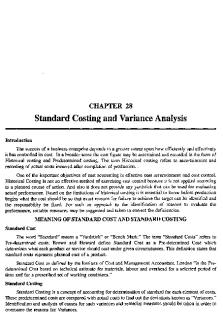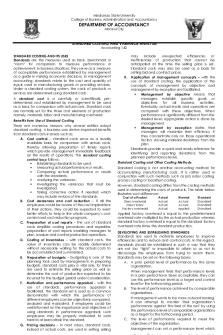Flexible Budget and Variance Analysis PDF

| Title | Flexible Budget and Variance Analysis |
|---|---|
| Course | Management Accounting II |
| Institution | The University of Adelaide |
| Pages | 4 |
| File Size | 133.2 KB |
| File Type | |
| Total Downloads | 11 |
| Total Views | 172 |
Summary
Variance analysis, Purposes, Favourable and Non-favourable variances, Price Variance, Efficiency variance, Variable overhead variance, Allocated variance, Reasons...
Description
Yue Wah Hung
a1805145
Week 9 Tutorial Questions 7-1 What is the purpose of variance analysis to management? (Pg264) The goal of variance analysis is for managers to understand why variances arise, to learn, and to improve their firm’s future performance continuously. Also, to evaluate performance after decisions are implemented. *budget works as a goal, target, basis for benchmarking, planning & control.
7.9
List three causes of a favorable direct materials price variance.
Definition: When the actual price to obtain direct material is better/lower than the price budgeted for input. 3 causes for favourable direct material price variance: An overall decrease in the market price level. Purchase of materials of lower quality than the standard (this will be reflected in adverse material usage variance). Better price negotiation by the procurement staff. Implementation of better procurement practices (e.g. invitation of price quotations from multiple suppliers) – Discounts from paying earlier? Purchase discounts on larger orders. (Economies of scale) Reasons for adverse material price variance include: o An overall hike in the market price of materials. o Purchase of materials of higher quality than the standard (this will be reflected in favourable material usage variance). o Increase in bargaining power of suppliers. o Loss of purchase discounts due to smaller order sizes. o Inefficient buying by the procurement staff. Causes of favourable direct material efficiency variance:
Fewer materials than the standard quantity was used in the production process. More efficient worker and supervisor practices. Higher quality of materials purchased. The purchase of more efficient machinery during period.
Yue Wah Hung
a1805145
8-6 Assume variable manufacturing overhead is allocated using machine-hours. Give three possible reasons for a favorable variable overhead efficiency variance. (Pg 305) The variable overhead efficiency variance is the difference between the actual quantity of the cost-allocation base used and budgeted quantity of the cost-allocation base that should have been used to produce the actual output, multiplied by the budgeted variable overhead cost per unit of the cost-allocation base. - Due to the difference between standard number of manufacturing hours and the actual hours worked during the period. Variable = depends on volume Costs = Direct material + Direct labour + Overhead (anything other than material and labour, eg. electricity, supervisor - variable ad hoc, fixed contract) Favourable variable overhead efficiency variance: Actual machine-hours used was lower than budgeted machine-hours allowed to manufacture. 3 reasons for favourable variable overhead efficiency variance: Use of a raw material which is easier to work with (this should be evident in a favourable material usage variance and possibly an adverse material price variance). Employment of a higher skilled labour or improvement of skills of existing workforce through training and development leading to improved productivity (this should be indicated by a favourable labour efficiency variance and potentially an adverse labor rate variance). Installation of a more efficient manufacturing equipment/ consistent maintenance. Planning error (e.g. ignoring or under estimating the impact of learning curve effect on productivity). Overestimation by new and inexperienced manager/accountant. Possible causes for adverse variance include: o Use of a cheaper raw material which is harder to work with (this should be corroborated with an adverse material usage variance and a favourable material price variance). o Inefficient production caused by the employment of lower skilled labour (this shall be evident in an adverse direct labour efficiency variance and probably a favourable labour rate variance). o Decline in the productivity of manufacturing equipment due to for example technical problems or wear and tear. o Planning error (e.g. over calculating the impact of learning curve effect on the manufacturing efficiency).
Yue Wah Hung
a1805145
8-21 Variable overhead, variance analysis. Ostrich Enterprise is a small production firm that operates in Sweden. The company produces meatballs for canteens. During June 2020, the standard variable overhead has been budgeted as follows: Budgeted variable overhead for the period 40,000 krona Budgeted volume of production for the period 80,000 units Actual variable overheads incurred during the period, which are under review, amounted to 56,000 krona, whereas the actual production were 96,000 units. Calculate the variable overhead variance. Variable Overhead Variance = Actual Costs Incurred - Allocated Amount Actual Costs Incurred = Actual Input Quantity x Actual Rate Actual Costs Incurred = 96,000 units x 0.583 krona = 56,000 krona
Allocated Amount = Budgeted Input Quantity allowed for actual output x Budgeted Rate Allocated Amount = 96,000 units x 0.5 krona = 48,000 krona Variable Overhead Flexible Budget Variance = 56,000 – 48,000 = 8,000 krona U
Actual Variable Overhead – Budgeted Variable Overhead = 56,000 krona – (96,000 units x (40,000krona/80,000krona) = 8,000 krona
Yue Wah Hung
a1805145
8-22 Fixed overheads, variance analysis in the service sector. Base Accountancy is an audit and consultancy firm that operates in New Queensland, Australia. The followings relate to its operation in August 2020. Standard time per unit Budgeted output Budgeted variable overhead A Actual output Actual hours worked Actual variable overhead A
4 hours 1,000 units $3,000 900 units 1,700 hours $2,680
Calculate the variable overhead cost variance, dividing the same into expenditure variance and efficiency variance. Variable Overhead Variance = Actual Costs Incurred - Allocated Amount Actual Costs Incurred = Actual Input Quantity x Actual Rate Actual Costs Incurred = 1,700 hours x $1.576 = $2,680
Allocated Amount = Budgeted Input Quantity allowed for actual output x Budgeted Rate Allocated Amount = (4 hours x 900 units) x $3,000/(4 hours x 1,000 units) = 3,600 hours x $0.75/hour = $2,700 Variable Overhead Flexible Budget Variance = $2,680 – $2,700 = $20 F Expenditure Variance = Actual Input Quantity x Budgeted Price – Actual Costs Incurred Expenditure Variance = 1,700 hours x $0.75/hour - $2,680 = $1,275 - $2,680 = $1,405 U Efficiency Variance = Actual Input Quantity x Budgeted Price – Flexible Budget Efficiency Variance = $1,275 - $2,700 = $1.425F Formula on Pg 305, 306 1. Actual Costs Incurred 2. Actual Input Quantity x Budgeted Price 3. Actual Output x Budgeted Input x Budgeted Price...
Similar Free PDFs

Chapter 4 Flexible Budget
- 3 Pages

Flexible Budgets and Overhead Analysis
- 120 Pages

Variance analysis
- 21 Pages

Standard-costs-and-variance-analysis
- 14 Pages
Popular Institutions
- Tinajero National High School - Annex
- Politeknik Caltex Riau
- Yokohama City University
- SGT University
- University of Al-Qadisiyah
- Divine Word College of Vigan
- Techniek College Rotterdam
- Universidade de Santiago
- Universiti Teknologi MARA Cawangan Johor Kampus Pasir Gudang
- Poltekkes Kemenkes Yogyakarta
- Baguio City National High School
- Colegio san marcos
- preparatoria uno
- Centro de Bachillerato Tecnológico Industrial y de Servicios No. 107
- Dalian Maritime University
- Quang Trung Secondary School
- Colegio Tecnológico en Informática
- Corporación Regional de Educación Superior
- Grupo CEDVA
- Dar Al Uloom University
- Centro de Estudios Preuniversitarios de la Universidad Nacional de Ingeniería
- 上智大学
- Aakash International School, Nuna Majara
- San Felipe Neri Catholic School
- Kang Chiao International School - New Taipei City
- Misamis Occidental National High School
- Institución Educativa Escuela Normal Juan Ladrilleros
- Kolehiyo ng Pantukan
- Batanes State College
- Instituto Continental
- Sekolah Menengah Kejuruan Kesehatan Kaltara (Tarakan)
- Colegio de La Inmaculada Concepcion - Cebu











